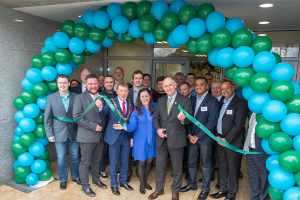Smart cities need two things to thrive : People + speedy Internet
This week’s Smart City roundup features a more affordable way to transition into smart cities, America’s “first” smart city, and a few ideas on the areas in which smart cities should be focused.
![]()
Silver Spring Network’s affordable smart city solution
Many cities’ goal might be to connect everything to the Internet so traffic will flow smoothly, energy and water consumption of the whole city can be better managed, and the quality of life can be increased for its inhabitants. But reality is often a different story, as funding can be sparse for such infrastructure projects.
Silver Spring Network, provider of smart grids, believe that turning into a smart city should not be an impossible task for any municipality. So it is expanding its hosted services for municipalities to aid in infrastructure improvement.
According to Anil Gadre, executive vice president of products and marketing at Silver Spring, municipalities wanting a smart city can start with distribution automation, an affordable onramp.
Silver Spring’s hosted services include the MicroAP networking card which has a cellular modem that can be used to connect a smart meter, but it is scalable as it creates a mesh network the more smart meters are connected to it. This makes it easier to monitor the network without having to hire outside help to connect or manage things.
LED lights consume less energy which makes them ideal for use in streetlights, but changing every bulb in the streets can be quite expensive for a municipality. Gadre believes that simply networking traditional lights can reduce energy costs by 40 percent, as well as reduce systems costs by as much as 30 percent.
Intel leads the way for America’s first smart city
The White House launched the SmartAmerica Challenge last year and Intel was quick to tackle the task, hoping to turn San Jose, CA into the first US smart city. Intel installed sensors throughout San Jose that are able to measure air and water pollution, noise, traffic flow, energy usage, communication, and public transportation use. Intel leveraged the Internet of Things and the cloud to connect all these sensors in a network that can be centrally managed and used for real-time analysis on the data gathered.
Though cloud security has been one of the main challenges in this connected network, the city is now able to monitor live statistics on transportation, air quality and more. The smart city project is in collaboration with San Jose’s Green Vision program. The joint project also opened up 25,00 local jobs related to clean technology, which is an added bonus to the convenience a smart city offers.
People and speedy Internet are needed in smart cities
It’s one thing to put sensors in almost every aspect of a city’s operations, from transportation to trash bins, but these efforts wouldn’t matter if residents cannot reap the benefits, or if data can’t be shared in real time due to slow Internet connections.
At the PlaceEXPO Future Cities event in Liverpool, England, many of the presenters showcased how they’re turning their cities into smart environments. Some, like the Spanish city of Santander, spent about €1 million (about $1.4) to roll out 20,000 sensors throughout the city to monitor garbage, air pollution, traffic conditions, and even parking spaces. Data gathered from these sensors deliver real-time information about the city, empowering its officials to make proper adjustments to reduce energy usage and ultimately city-wide spending.
Rob Moyser, associate director of Buro Happold, a British consultancy firm, believes that not all smart cities are actually smart, as they only “implement high tech solutions with a narrow focus.”
Moyser added that what makes a smart city effective is the citizens interacting with the technology, as well as providing them with high speed Internet connection. He believes that providing people with transport links will encourage people to use sustainable commuting, and access to fast Internet allows citizens to efficiently utilize smart offerings by the city.
photo credit: Stuck in Customs via photopin cc
A message from John Furrier, co-founder of SiliconANGLE:
Your vote of support is important to us and it helps us keep the content FREE.
One click below supports our mission to provide free, deep, and relevant content.
Join our community on YouTube
Join the community that includes more than 15,000 #CubeAlumni experts, including Amazon.com CEO Andy Jassy, Dell Technologies founder and CEO Michael Dell, Intel CEO Pat Gelsinger, and many more luminaries and experts.
THANK YOU











